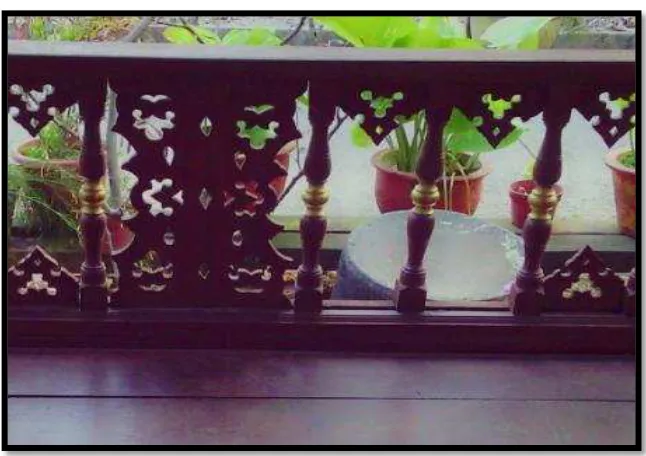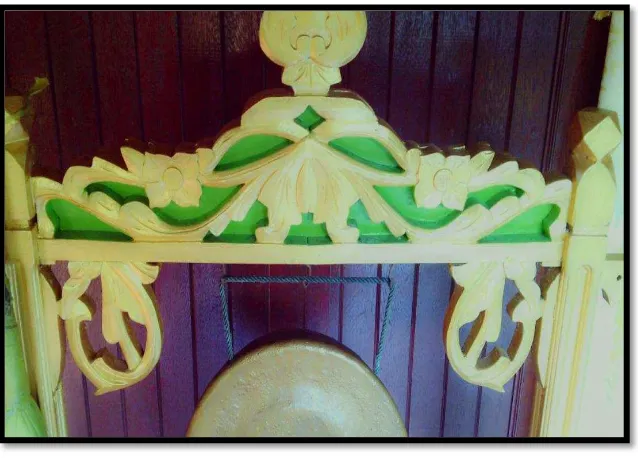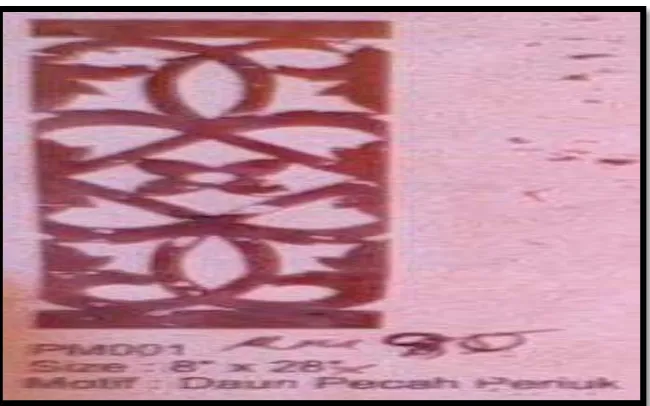UNIVERSITI TEKNIKAL MALAYSIA MELAKA
THE APPLICATION OF TIME COMPRESSION
TECHNOLOGIES OF AN ARTIFACT IN MALAY CARVING
(MOULD OF ‘PAPAN PEMANIS’)
This report submitted in accordance with requirement of the Universiti Teknikal Malaysia Melaka (UTeM) for the Bachelor Degree of Engineering Technology
(Manufacturing Product Design) (Hons.)
by
MOHAMMAD SYAFIQ BIN MOHD SARIF
B071110417
890212-10-5101
APPROVAL
This report is submitted to the Faculty of Engineering Technology of UTeM as a partial fulfillment of the requirements for the degree of Bachelor of Engineering Technology (Manufacturing Product Design) (Hons.). The member of the supervisory is as follow:
UNIVERSITI TEKNIKAL MALAYSIA MELAKA
BORANG PENGESAHAN STATUS LAPORAN PROJEK SARJANA MUDA
TAJUK: The Application of Time Compression Technologies (TCT) for Data Acquisition of An Artifact in Malay Carving (Mold for Papan Pemanis)
SESI PENGAJIAN: 2014/2015 Semester 1
Saya MOHAMMAD SYAFIQ BIN MOHD SARIF
mengaku membenarkan Laporan PSM ini disimpan di Perpustakaan Universiti Teknikal Malaysia Melaka (UTeM) dengan syarat-syarat kegunaan seperti berikut:
1. Laporan PSM adalah hak milik Universiti Teknikal Malaysia Melaka dan penulis. 2. Perpustakaan Universiti Teknikal Malaysia Melaka dibenarkan membuat salinan
untuk tujuan pengajian sahaja dengan izin penulis.
3. Perpustakaan dibenarkan membuat salinan laporan PSM ini sebagai bahan pertukaran antara institusi pengajian tinggi.
4. **Sila tandakan ( )
SULIT
TERHAD
TIDAK TERHAD
(Mengandungi maklumat yang berdarjah keselamatan atau kepentingan Malaysia sebagaimana yang termaktub dalam AKTA RAHSIA RASMI 1972)
(Mengandungi maklumat TERHAD yang telah ditentukan oleh organisasi/badan di mana penyelidikan dijalankan)
Alamat Tetap:
No. 39 Jln Sri Bayu 8, Tmn Sri Bayu,
Bagan Lalang, 43950 Sg. Pelek
Sepang, Selangor.
Tarikh: ________________________
Disahkan oleh:
Cop Rasmi:
Tarikh: _______________________
DECLARATION
I hereby, declared this report entitled “The Application of Time Compression Technologies (TCT) for Data Acquisition of An Artifact in Malay Carving
(Mould for ‘Papan Pemanis’)” is the results of my own research except as cited in references.
Signature : ……….
Author‟s Name : Mohammad Syafiq Bin Mohd Sarif
iii
DEDICATION
To my beloved parents, Mohd Sarif Bin Jantan and Seliah Binti Gani,
To my siblings Izzat Faris, Khabir Thariq, and Dinie Akmal,
To my supervisor,Mr. Hambali Boejang,
To Mr. Zulkifli Samad as carving marker,
iv
ACKNOWLEDGEMENT
First and foremost, Alhamdulillah, I would like to praise Allah for giving me the strength to endure the Projek Sarjana Muda (PSM) period with a great success. It is known that, this PSM is one of the most important subjects that must be endured by all UTeM‟s students as requirement to get a degree.
I would like to thank to my project supervisor Mr. Hambali Bin Boejang for his commitment, support, advice, time shared and guidance given. He helps contribute lots in order to complete this project successfully. Not forgotten, for all lectures and technicians involves with their invaluable support, cooperation, shared of information and also their experiences.
I would also like to express greatest thankful to my beloved parents, Mr Mohd Sarif Jantan and Mrs Seliah Gani for giving me their support and motivation during my good and hard times in order to ensure completion of this project. Not forgotten, special thanks to Mr. Zulkifli Samad as carving marker in order to give information about Malay Carvings. Furthermore, thanks to all who directly or indirectly help in contribution and full support though the project period.
Lastly, I would like to apologize for my wrong-doing and mistake during this PSM period. I hope all knowledge and experience that I gathered in this PSM can help me in my career in the future.
Thank you again.
Wassalam.
i
ABSTRAK
ii
ABSTRACT
xii
LIST OF ABBREVIATIONS, SYMBOLS AND
NOMENCLATURE
ABS - Acrylonitrile Butadiene Styrene BFB - Bits From Bytes
CAD - Computer Aided Design CE - Concurrent Engineering
CMM - Coordinate Measurement Machine TCT - Time Compression Technologies SOP - Standard Operation Procedure 3D - Three Dimensional
USB - Universal Serial Bus RP - Rapid Prototyping
ix
Carving for music instrument Daun Pecah Periuk pattern Pucuk Kacang pattern Bunga Ketumbit pattern Bunga Bayam Peraksi pattern
Traditional work process flow for making a mould
Mould that will be use foe Timber Bracket „Papan Pemanis‟ The edge of the „Papan Pemanis‟ mould
Carving at entrance of house
Schematic diagram of integrated RE within rapid product development process
Touch probe contact scanning
Example point of cloud of water pump that produced by contact technique
Non-contact scanning device
Schematic diagram of simple laser triangular
Example of point of water pump that resulting from non-contact technique
The schematic diagram of triangle tessellation of STL file Schematic diagram of overall RP process chain
Schematic diagram of SLA The SLA5000 machine
Schematic diagram of 3D printing Printing machine
x
Leader Metrology CMM machine Mould have been clean
Camera (grey colour) have been installed Calibration ball
Calibration interface
Laser and camera at middle on the ball Calibration line
Scanned data of mould Geomagic software interface Selected area to delete Fill holes tab
Selected area to be filled Surface had been upgraded Create patch layout
IGES file format
Imported curve of the IGES data Selected entities
Extrude boss of mould Top plan view of mould Corner shape before editing Corer that had been trim STL file description Bits for bytes machine
xi
Parameter in dialog box Cutting line
Part pages dialog box Mould cut 1 part orientation Build setting parameter Estimated build time for cut 1 Cut 2 part orientation
Cut 3 part orientation Cut 4 part orientation Save built G code tab Cube stick for 3D printer Glue on platform
viii
LIST OF TABLES
1 2
Build time for both mould
Dimensional of difference feature in difference test
v
2.2 Concurrent Product Development Time Compression Technologies 12
2.2.0 Introduction 12
2.4.1 Fundamental and Basic Principle of CAD 20
2.4.2 The Application of CAD 21
vi
3.2 Identification Scanned Object / Product 33 3.3 Scanning 34 3.3.1 Scanning Process Procedure 35
3.4 CAD data Manipulation 41 3.4.1 Data Manipulation Experimental Wok 41 3.4.1.1 Trim 41
3.4.1.2 Editing 45 3.5 Prototype Fabrication 49 3.5.1 Rapid Prototyping Process 50 3.5.1.1 Pre-Processing 50 3.5.1.1.1 Slicing 50 3.5.1.1.2 Generate BFB Fie 52 3.5.1.1.3 Fabricate Prototype 56
3.6 Analysis 60 3.6.1 Work Procedure for Analysis 60
CHAPTER 4: RESULT AND DISCUSSION 62 4.0 Introduction 62
4.1 Prototype 62 4.2 Lead Time 63 4.2.1 Comparisons between actual mould with prototype mould 65
vii CHAPTER 5: CONCLUSIONS AND RECOMMENDATION 70
5.0 Conclusion 70
5.1 Recommendation 71
REFERENCES 72
APPENDIXES
1. Gantt Chart
2. Types of Carving Pattern 3. Interview Question
1
CHAPTER 1
INTRODUCTION
1.0 Introduction
The application of Concurrent Engineering (CE) in product design and development has given significant impact on the entire product planning process. Most of the manufacturers has practiced CE by adopting Time Compression Technology (TCT) in product design and development process because it decreases lead time, improved quality, and reduced cost (Boejang H., Basar M. F., 2013). Many industries have achieved remarkable advantages after implementing CE in their new product development process. By executing design in parallel, improvements occur in many areas such as communication, quality, production processes, cash flows, and profitability. The reductions of time to market which has strategic importance, allows companies to increase their market share and reduce design changes and iterations [Boejang H., Basar M. F., Yahya M.S., 2013).
2 This project is carried out to understand the application of TCT in the product development process on an artifact / hand made product. The selected product for this case study is a mould that is needed in making sketch on „Papan Pemanis‟
1.1 Objective of Project
There are two objectives that have to be achieved in this Bachelor Degree Project :
1. To produce prototype of „Papan Pemanis‟ mould by using Bits from Bytes (BFB) Machine model 3D Touch Double.
2. To compared lead time of traditional method in fabrication process of mould against modern approach.
1.2 Scope of Project
The work scopes of this project are :
1. Literature Reviews.
2. Interview sessions.
3. Select hand craft product to be studied.
4. Design and develop mold for selected product (papan pemanis) using TCT.
3 1.3 Problem Statement
RE is the process of extracting missing knowledge from anything man-made product or physical object such as CAD data (Moitinho V. Barcelo J. A., 2010). Thus, this project focuses on getting CAD data from a master pattern of a „Papan Pemanis‟ and maintaining the quality of the human touch in mould making process. Furthermore, the craftman takes a long time to make a mould in which it requires one or two days lead time, depending on the types of carving works. Nowadays, many young people are less or not interested in the art of carving. So it is not impossible in 5 to 10 years from now this art will extinct because there is less interest in this artistic activities. There are young people who know make sculptures but do not know how to make a mold. So, the mould is the most important tool before making a carving, especially in the fabrication of „Papan Pemanis‟.
4
CHAPTER 2
LITERATURE REVIEW
2.0 Introduction
This chapter covers explaination on how information are gathered. The informations will be used as a guidelines in order to complete the research work. The main source of information was identified as following:
1. Books.
2. Journals.
3. Interview.
2.1 Introduction to Art of Malay Carvings
This chapter gives some insights on the wood handcraft products that is used in traditional Malay house. It explain and discusses the method on how information are gathered on Malay wood craftmanshift, the mould making for „Papan Pemanis‟, and types of patterns and products.
5 interviews. This interview was conducted at the Malacca Traditional House where it is dedicated to locate the wood carving industry and its‟ products. The location of this house is on the opposite of the Perigi Hang Tuah, Kampung Duyung, Melaka. Figure 2.0 (a), (b) and (c) below shows some of the wood carving products that were produced by Mr. Zainal Samad :
Figure 2.0(a): Carving for building.
6 Figure 2.0(b): Carving for weapon.
(Courtesy from: Mr. Zulkifli Samad)
Figure 2.0(c) : Carving for music instrument.
7 2.1.0 Interviews
One of the renowned sculptors is Mr. Zulkifli Samad, 44 years old. He has involved in this field since he was 10 years old at the time where he just a helper to his father. The wood carving in Malay tradition is applicable in the production of decorative items such as „Papan Pemanis‟, malay traditional weapons, and music instruments. These products are used for various purposes. For example, traditional Malay house, and the theme used in wood carving is unique and distinctive. In earlier times, carving is very symbolic to certain society; and in Melaka, the theme used in a particular wood carving work is based on flora and fauna. The interviews were conducted merely to understand the wood carving process for decorative items for the traditional Malay house.
The process is the mold making process for the production of „Papan Pemanis‟. There many types of carving patterns that normally used in making „Papan Pemanis‟ for traditional Malay house or building. Most of them are used mainly as partition panels, and timber bracker. These are shown in Figure 2.1, 2.2, 2.3 and 2.4. The other types of carving patterns are shown in appendix 2.
1. Partition panel
a. Daun Pecah Periuk.


